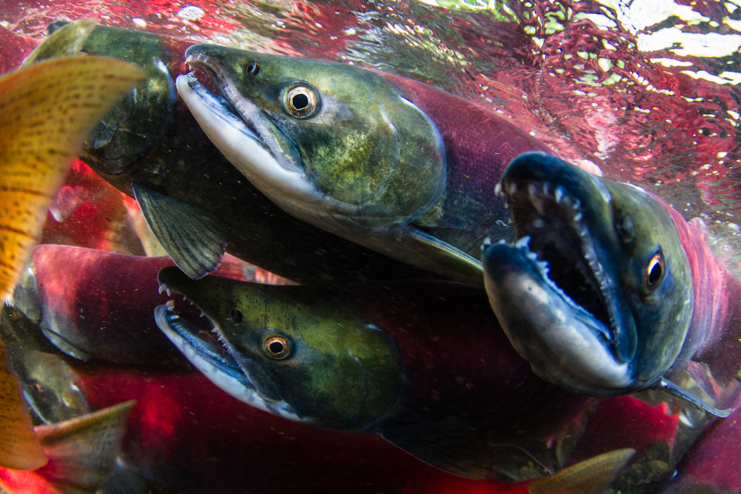
Starting in the summer and peaking in the fall, our local salmon embark on a lengthy and laborious journey from Puget Sound to their native rivers, streams, and lakes. These efforts, which will ultimately end in their death, is known as the salmon run. The reason for their fatal trek? Spawning time.
Heading home
If you’ve visited a stream or river recently, you may have noticed the faint splashing of tails, or even smelled an unlucky fish who has found their eternal resting spot. What you’re witnessing is the “homing” period, when the salmon have decided – either by smell, cognitive magnetic sensing, or some magic cosmic signal – to journey upstream to their birthplace and reproduce. During this trip, they experience significant changes as they shift from the salt water of the ocean to the fresh waters of our streams and rivers. These changes include an adjustment in swimming muscles, an increase in reproductive preparedness, and even a new color coat. Most salmon also stop eating when they begin their freshwater journey, putting all their energy into swimming upstream.
While salmon of one species may all look similar, each spawning population is uniquely genetically adapted to their natal river, stream, or lake ecosystem. The lucky ones even make it far enough to spawn in the same gravel bed in which they were born.
A life complete
In addition to navigating against the river current while experiencing metabolic transformation, the long-suffering female salmon must also create nesting pits for her eggs. This is done by laying on her side and whipping her tail back and forth repeatedly. These nests, or redds, can be easily spotted if you keep your eyes out for clear areas of exposed gravel. Once the eggs are laid, fertilized, and covered with another layer of gravel for protection, the parents’ hard work is done and their lives come to an end. By this time, many of the fish are malnourished and battered from the upstream fight and cannot survive a trip back to the ocean.
Although their lives may seem tragic to us, salmon death plays an important role in sustaining the health of the surrounding ecosystem. As a keystone species, their presence supports and nourishes the broader food chain. When they die, their carcasses are either eaten or absorbed by the soil, providing rich ocean nutrients to the inland watershed.
The next generation
In the river, the young salmon hatch and mature, feeding on larvae and occasionally the carcasses of their parents. Once they are old enough, they migrate downstream and enter the ocean, where they live and feed for another one to four years before returning home. Come spring, you can catch these young river salmon riding the snow melt as they make their way to the sea.
Support local salmon populations
Salmon populations have been declining dramatically due to increased industrialization and development practices that destroy salmon habitat and contaminate our watersheds. Here are some ways you can support the health of our salmon and their ecosystems:
- Support sustainable fishing practices.
- Protect the watershed by properly and safely disposing of hazardous waste (batteries, motor oil, soaps, expired medication, etc.).
- Prevent contaminated runoff from entering the ocean, streams, and rivers by planting native plants – or even a rain garden – and avoid using pesticides.
- Don’t walk on spawning beds, and – no matter how bad they smell – don’t remove dead salmon from the river.
- Volunteer with local salmon conservation and watershed restoration organizations.
Viewing the salmon run
The salmon are working hard to get back upstream, and there are many spots in the Pacific Northwest to watch them run!
- Chuckanut Creek, Bellingham
- Legion Park, Everett
- 5th Avenue Bridge, Olympia
- Sammamish River Trail, Redmond
- Piper’s Creek, Seattle
- Clark Creek, Tacoma
- Salmon Haven at Dickerson Creek, Kitsap
- Chico River on the Kitsap Forest Theater Property, Kitsap
- Find more locations by checking out the Department of Fish and Wildlife's salmon viewing map.
LEAD IMAGE of a run of Sockeye salmon. Photo by Jonny Armstrong, Oregon State University. https://bit.ly/3p77hjv
This article originally appeared in our fall 2022 issue of Mountaineer magazine. To view the original article in magazine form and read more stories from our publication, visit our magazine archive.
 Skye Michel
Skye Michel